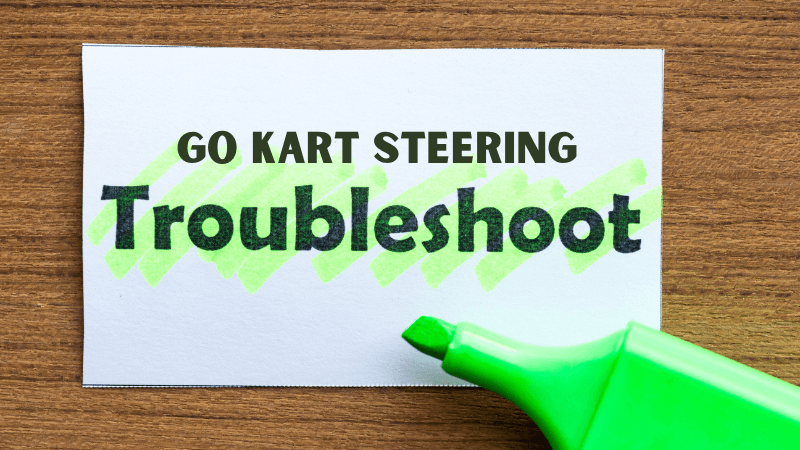Does it feel like you really have to crank the steering wheel hard any time you turn the go kart left or right? Do tight corners that were once easy seem almost impossible now?
Steering that’s becoming difficult and stiff can suck the fun right out of racing.
When every lap means fighting with a heavy wheel, your hands, arms, and shoulders end up sore and fatigued.
But don’t worry – In this post, I’ll explain the reasons behind why go kart steering hard to turn and what to do in each situation.

Table of Contents
Toggle#1 Binding In Steering Components
If your go-kart used to steer easily but now it’s hard, the problem might be in the steering parts.
Also Read: Do Go-Karts Have Power Steering?
If you’ve been in some races and had typical bumps or crashes, things like tie rods, kingpins, spindles, and other important stuff in the steering system could be bent.
When these parts get damaged, they might get stuck and limit how well your steering works.
Solution
Take a good look at your steering parts, like the tie rods, spindles, kingpins, and bushings. Check for cracks or if they’re not lined up correctly.
If you spot any bent pieces, replace them with new ones.
When you’re reinstalling these, take photos or mark the current hardware setup to make sure everything goes back the right way.
Improperly installed parts can also make the kart hard to turn.
#2 Improper Steering Adjustments
Incorrect alignment settings can make the kart hard to steer too.
Too much positive caster or camber makes it harder to turn the wheel because there’s more resistance.
And if the toe settings are way off, it might scrub speed, but it also takes away from how quickly and easily you can steer.
Solution
You can use tools like the Drysdales Sniper system to get precise alignment measurements.
After that, reset everything to the factory specs that match your chassis make and model.
When you’re measuring, make sure the kart is on the ground, not just sitting on a stand. This way, you’ll get accurate readings for a spot-on alignment.
#3 Over Tightened Steering Shaft
Some steering shaft assemblies use locking collars to secure column position.
Overtightening these collars can cause a problem – when the chassis flexes under your weight, it can jam up the steering column, making it hard to turn smoothly.
Also Read: Go Kart Brakes Not Working
Solution
To fix this, try loosening the bolts on the shaft collar in small half-turn steps. See if this eases up the effort needed to steer.
Aim for a bit of play in the shaft so it can move when the frame deals with forces.
Just be careful not to go too loose and risk things getting wobbly.
#4 Tire Issues
Tire issues can make your go kart hard to steer too.
Having tires that are either not inflated properly (low pressure) or are too soft for your driving style and the track conditions can mess things up.
When your tires are under-filled, they flex too much, causing the chassis to bind and making the front end feel unclear.
Soft tires tend to roll when you’re taking corners instead of staying firm, and this not only slows you down but also affects how the kart handles.
Solution
Double-check that you’re using the right tire compound; generally, a harder compound gives you a sharper response.
After that, make sure the tire pressure is correct.
If you are not sure, you can look up the recommended settings for your specific tire brand and model in the factory guidance.
If you want to get really precise, think about using tire temperature tools to fine-tune your setup.
#5 Bent Or Damaged Frame
If you’ve had a serious crash, it’s possible that it bent the frame of your go-kart.
A bent or damaged frame can make Go kart steering hard because this kind of damage messes with important steering alignments like caster, camber, and toe.
As a result, it throws off how the wheels respond to your steering, making your kart handle differently than it should.
Solution
Take a good look at the frame rails and cross braces to see if they’re symmetrical.
You can also use specialized tools like a chassis jig, along with trammels and levels, to diagnose any bends in the frame.
If the damage is significant, you might have to either straighten the frame or replace it entirely. It’s crucial to leave this kind of work to experienced chassis builders who know how to handle it.
#6 Driving Style / Technique Flaws
Finally, issues with driving technique can make even a perfectly normal kart feel hard to steer.
Also Read: Do Go-Karts Have Differentials?
If you’re wrestling with the wheel, gripping it too tightly, or “fighting” against the natural movement of the chassis, it can lead to fatigue and make the steering feel harder than it is.
Fixating on a specific point can also mess with how you perceive your speed in corners.
Solution
Focus on having the right-hand position – thumbs up, a light grip, and pushing to turn rather than pulling.
Let the wheel move smoothly through your palms instead of trying to control it too much.
Keep your arms relaxed to avoid building tension.
Get to know your kart and tire limits through testing, gradually exploring slip angles to build confidence. Adjusting your technique might take time, but it pays off in the end.



